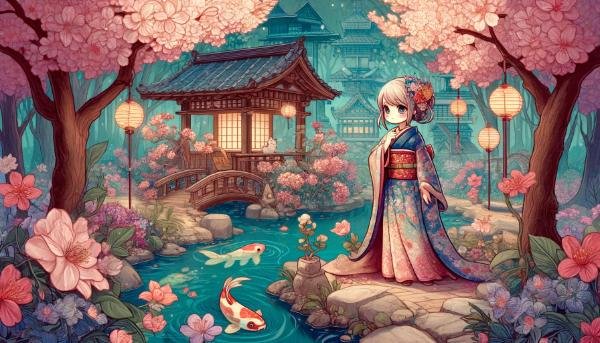Welcome to a world where heroes embark on heroic adventures, mythical creatures roam, and moral lessons unfold before your very eyes. Japanese fairy tales, a beautiful tapestry of Japan’s rich cultural heritage, have captivated the hearts of both young and old for centuries.
These stories are not just entertaining bedtime tales; they are a reflection of the deep-seated cultural values and storytelling traditions that Japan holds dear. Let us take a journey into the enchanting realm of Japanese folklore and discover the magic that has been passed down through generations.
What are the most popular Japanese fairy tales?
The land of the rising sun has produced some of the most beloved Japanese fairy tales admired across the world. Classics such as “Momotarō,” the tale of a boy born from a peach who goes on to fight demons, and “Issun-bōshi,” the story of a one-inch tall warrior, are staples in the realm of timeless Japanese folklore stories.
“Kintarō,” often known as the Golden Boy, is another fan favorite, featuring a child with superhuman strength. These tales, among others, form the core of Japan’s narrative identity and continue to be a source of moral instruction and entertainment.
It’s not just the excitement of adventure that makes these stories stand out; it’s the infusion of morals and lessons that resonate with listeners of all ages, teaching them the values of courage, kindness, and wisdom.
How do Japanese folk tales influence culture?
Japanese folk tales are not just stories; they’re the threads that weave the cultural fabric of the nation. Stories like “The Tongue-Cut Sparrow” and “The Bamboo-Cutter and the Moon-Child” offer more than a glimpse into a fantasy world; they offer insight into the societal norms and cultural values of Japan.
The influence of these tales extends beyond simple storytelling; they embody the principles of harmony, respect, and the balance between man and nature. As such, Japanese folklore plays a pivotal role in shaping the cultural consciousness of the country.
These narratives, steeped in history and tradition, serve as educational tools, imparting moral lessons and instilling a sense of national pride and identity.
Where to find Japanese fairy tales for beginners?
For those new to the world of Japanese myths and folk narratives, finding the right entry point can be as exciting as the stories themselves. A great place to start is Yei Theodora Ozaki’s fairy tale collection, which offers a wide range of stories accessible to readers of all ages.
Many of these tales are available in children’s books, online resources, and even audiobooks, allowing for an immersive experience into the world of Japanese fairy tales.
Libraries and bookstores often have sections dedicated to folk tales from around the world, where you can find beautifully illustrated editions that bring these stories to life.
Why are Japanese bedtime stories important for children?
Bedtime stories are a cherished tradition in many cultures, and Japan is no exception. Bedtime fairy tales from Japan provide not just an opportunity for children to wind down before sleep but also serve as a conduit for passing down important life lessons and cultural heritage.
In a world where the moral compass is increasingly complex, the simplicity and depth of Japanese fairy tales offer a clear path to understanding right from wrong, strength in adversity, and the importance of perseverance.
Furthermore, these stories foster imagination and creativity, allowing children to explore fantastical worlds while safely tucked in their beds.
Can you learn Japanese values from folk stories?
Japanese folk stories are a treasure trove of wisdom, with each tale intricately woven with the values that define the Japanese way of life. Respect for nature, the importance of humility, and the virtues of hard work and patience are just a few of the lessons embedded within these narratives.
It’s through the adventures of characters like Momotarō and the perseverance of Issun-bōshi that children learn the ideals that are valued in society, making these stories a vital tool in cultural education.
As such, Japanese fairy tales are more than just entertainment; they are a reflection of the nation’s soul, teaching timeless values that transcend generations.
Who was Yei Theodora Ozaki and her role in fairy tales?
Yei Theodora Ozaki occupies a special place in the world of Japanese fairy tales. Her role as a translator and curator has been instrumental in introducing these stories to a Western audience.
Ozaki’s work involved not just the translation of language but the delicate task of preserving the authentic spirit of the tales while making them accessible and enjoyable for readers unfamiliar with Japanese customs and language.
Her collections, such as “Japanese Fairy Tales,” have become essential reading for anyone interested in the folklore of Japan, ensuring that the charm and wisdom of these stories are not lost in translation.
Related Questions on Japanese Fairy Tales
What are some lesser-known Japanese fairy tales?
While tales like Momotarō and Kintarō are well-known, there are many other captivating stories that are less familiar to the wider audience. “The Tale of the Bamboo Cutter,” also known as “The Tale of Princess Kaguya,” is a poignant story of a moon princess who is found by a bamboo cutter and is raised on Earth.
“Urashima Tarō,” another lesser-known gem, tells the story of a kind fisherman who visits an undersea kingdom. These and other stories offer a rich tapestry of Japanese folklore waiting to be discovered.
How do Japanese fairy tales compare to those from other cultures?
Japanese fairy tales, while unique in their cultural context, share universal themes with tales from other cultures. Stories of transformation, quests, and triumphs over adversity can be found in many cultures, illustrating the common threads that run through humanity’s storytelling traditions.
However, the distinct settings, mythical creatures, and moral perspectives provide a fresh lens through which to view these universal themes, showcasing the diversity and richness of global folklore.
In conclusion, Japanese fairy tales are a fascinating exploration into the heart of Japan’s culture. They offer a vibrant blend of entertainment, education, and cultural preservation that continues to captivate audiences worldwide. Whether through the heroic exploits of Momotarō or the tiny triumphs of Issun-bōshi, these tales remain an enduring part of Japan’s cultural legacy, sharing its values and stories with the world, one enchanting tale at a time.


Leave a Reply